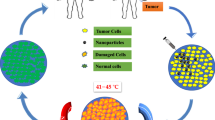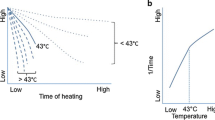Abstract
Magnetic fluid hyperthermia is a new subclass of hyperthermia cancer treatment that can selectively heat up a tumor without damaging the surrounding healthy tissues. Some authors studied the temperature distribution of a magnetically mediated tumor assuming a homogeneous distribution of nanoparticles inside the tumor. Practically speaking, the injected nanoparticles do not usually distribute uniformly throughout the entire tumor, thus leaving some parts of the tumor without nanoparticles. In this study, an inhomogeneous dispersion of nanoparticles inside the tumor is assumed to investigate the tissues’ temperature profiles. The problem is solved for polar coordinate. Also in this study, the heating effect of magnetic fluid in a porcine liver tissue is experimentally examined. Numerical transient solutions are found to be in good agreement with experimental data.
Similar content being viewed by others
Change history
26 February 2019
There is one correction to make to the original article.
References
M. H. Falk and R. D. Issels, Hyperthermia in oncology, International Journal of Hyperthermia, 17(1) (2001) 1–18.
M. H. Seegenschmiedt, P. Fessenden and C. C. Vernon, Thermoradiotherapy and thermochemotherapy, Vol. 1: Biology, Physiology and Physics, Berlin: Springer-Verlag (1995).
R. D. Issels, Hyperthermia adds to chemotherapy, European Journal of Cancer, 44(17) (2008) 2546–2554.
C. W. Song, A. Shakil, R. J. Griffin and K. Okajima, Improvement of tumor oxygenation status by mild temperature hyperthermia alone or in combination with carbogen, Seminars in Oncology, 24(6) (1997) 626–632.
J. van der Zee, Heating the patient: a promising approach? Annals of Oncology, 13(8) (2002) 1173–1184.
Gilchrist, Selective inductive heating of lymph nodes, Annals of Surgery (1957) 146596.
T. Hosono, H. Takahashi, A. Fujita, R. J. Joseyphus, K. Tohji and B. Jeyadevan, Synthesis of magnetite nanoparticles for AC magnetic heating, Journal of Magnetism and Magnetic Materials, 321(19) (2009) 3019–3023.
A. Jordan, R. Scholz, P. Wust, H. F. hling and R. Felix, Magnetic fluid hyperthermia (MFH): Cancer treatment with AC magnetic field induced excitation of biocompatible superparamagnetic nanoparticles, Journal of Magnetism and Magnetic Materials, 201 (1999) 413–419.
Rosensweig, Heating magnetic fluid with alternating magnetic field, Journal of Magnetism and Magnetic Materials, 252 (2002) 370–374.
G. F. Goya, R. Fernandez-Pacheco, M. Arruebo, N. Cassinellib and M. R. Ibarra, Brownian rotational relaxation and power absorption in magnetite nanoparticles, Journal of Magnetism and Magnetic Materials, 316 (2007) 132–135.
V. Cabuil, V. Dupuis, D. Talbot and S. Neveu, Ionic magnetic fluid based on cobalt ferrite nanoparticles: Influence of hydrothermal treatment on the nanoparticle size, Journal of Magnetism and Magnetic Materials, 323 (2010) 1238–1241.
C. Alexiou, R. J. Schmid, R. Jurgons, M. Kremer, G. Wanner and C. Bergemann, et al, Targeting cancer cells: magnetic nanoparticles as drug carriers, European Biophysics Journal, 35 (2006) 446–50.
F. M. Martin-Saavedra, E. Ruiz-Hernandez, A. Bore, D. Arcos and M. Vallet-Regi, Magnetic mesoporous silica spheres for hyperthermia therapy, Acta Biomaterialia, 6 (2010) 4522–4531.
I. Hilger, R. Hiergeist, R. Hergt, K. Winnefeld, H. Schubert, and W. A. Kaiser, Thermal ablation of tumors using magnetic nanoparticles: an in vivo feasibility study, Investigative Radiology, 37 (2002) 580–586.
S. Jones, J. Winter and B. Gray, Treatment of experimental rabbit liver tumours by selectively targeted hyperthermia, International Journal of Hyperthermia, 18 (2002) 117–128.
A. Jordan, R. Scholz and K. Maier-Hauff et al, The effect of thermotherapy using magnetic nanoparticles on rat malignant glioma, Journal of Neuro-oncology, 78 (2006) 7–14.
H. H. Pennes, Analysis of tissue and arterial blood temperatures in the resting human forearm, Journal of Applied Physiology, 1 (1948) 93–122.
Z. S. Deng and J. Liu, Analytical study on bioheat transfer problems with spatial or transient heating on skin surface or inside biological bodies, Journal of Biomechanical Engineering, 124 (2002) 638–649.
H. G. Bagaria and D. T. Johnson, Transient solution to the bioheat equation and optimization for magnetic fluid hyperthermia treatment, International Journal of Hyperthermia, 21(1) (2005) 57–75.
W. Andra, C. G. d’Ambly, R. Hergt, I. Hilger and W. A. Kaiser, Temperature distribution as function of time around a small spherical heat source of local magnetic hyperthermia, Journal of Magnetism and Magnetic Materials, 194 (1999) 197–203.
J. W. Durkee, P. P. Antich and C. E. Lee, Exact-solutions to the multiregion time-dependent bioheat equation. 1. Solution development, Physics in Medicine and Biology, 35(7) (1990) 847–867.
M. Suto, H. Kosukegawa, K. Maruta, M. Ohta, K. Tohji and B. Jeyadevan, Heat diffusion characteristics of magnetite nanoparticles dispersed hydro-gel in alternating magnetic field, Journal of Magnetism and Magnetic Materials, 321(20) (2009) 3483–3487.
M. Liangruksa, R. Ganguly and I. K. Puri, Parametric investigation of heating due to magnetic fluid hyperthermia in a tumor with blood perfusion, Journal of Magnetism and Magnetic Materials, 323 (2011) 708–716.
N. A. Brusentsov, L. V. Nikitin, T. N. Brusentsova, A. A. Kuznetsov, F. S. Bayburtskiy, L. I. Shumakov and N. Y. Jurchenko, Magnetic fluid hyperthermia of the mouse experimental tumor, Journal of Magnetism and Magnetic Materials, 252 (2002) 378–380.
X. Wang, H. Gu and Z. Yang, The heating effect of magnetic fluids in an alternating magnetic field, Journal of Magnetism and Magnetic Materials, 293 (2005) 334–340.
S. Balivsada1, R. S. Rachakatla1 and H. Wang, A/C magnetic hyperthermia of melanoma mediated by iron(0)/iron oxide core/shell magnetic nanoparticles, BMC Cancer, 10 (2010) 119.
A. Roggan, Dosimetrie thermischer Laseranwendungen in der Medizin — Untersuchung der optischen Gewebeeigenschaften und physikalisch-mathematische Modellentwicklung, ecomed, Landsberg/Lech (1997) 16.
Annette M. Schmidt, Thermoresponsive magnetic colloids, Colloid Polym Sci, 285 (2007) 953–966.
Author information
Authors and Affiliations
Corresponding author
Additional information
Recommended by Associate Editor Dongsik Kim
Mohammad Mahdi Attar received his B.S. degree from Bu-Ali Sina University, Hamedan, Iran, in 2005, M.S. degree, in 2008, Shahid CHamran University, Ahwaz, Iran. Eng. Mohammad M. Attar is currently a Ph.D. Candidate at Science and Research Branch, Islamic Azad University, Tehran, Iran. Eng. Attar is also currently a faculty member at the Hamedan Branch, Islamic Azad University, Hamedan, Iran. His research interests are focused on thermal management, Hyperthermia, and Thermal Stress.
Rights and permissions
About this article
Cite this article
Attar, M.M., Haghpanahi, M., Amanpour, S. et al. Analysis of bioheat transfer equation for hyperthermia cancer treatment. J Mech Sci Technol 28, 763–771 (2014). https://doi.org/10.1007/s12206-013-1141-4
Received:
Revised:
Accepted:
Published:
Issue Date:
DOI: https://doi.org/10.1007/s12206-013-1141-4




